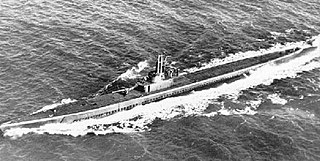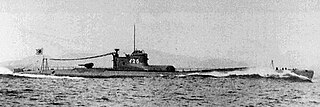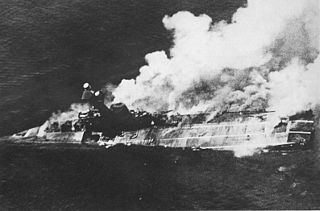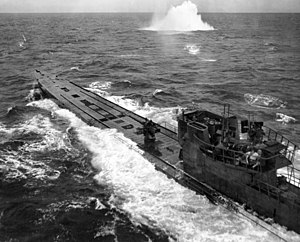
USS Bowfin (SS/AGSS-287), is a Balao-class submarine of the United States Navy named for the bowfin fish. Since 1981, she has been open to public tours at the USS Bowfin Submarine Museum & Park in Pearl Harbor, Hawaii, next to the USS Arizona Memorial Visitor Center.

USS Grayback (SS-208), a Tambor-class submarine, was the first ship of the United States Navy to be named for the lake herring, Coregonus artedi. She ranked 20th among all U.S. submarines in total tonnage sunk during World War II, with 63,835 tons, and 24th in number of ships sunk, with 14. She was sunk near Okinawa on 27 February 1944. Her wreck was discovered in June 2019.

USS Flying Fish (SS/AGSS-229), a Gato-class submarine, was the first submarine and second ship of the United States Navy to be named for the flying fish. Flying Fish is credited with having sunk a total of 58,306 tons of Japanese shipping and received 12 battle stars for World War II service.

USS Flasher (SS-249) was a Gato-class submarine which served in the Pacific during World War II. She received the Presidential Unit Citation and six battle stars, and sank 21 ships for a total of 100,231 tons of Japanese shipping, making her one of the most successful American submarines of the War. She was the first ship of the United States Navy to be named for the flasher.

USS Seahorse (SS-304), a Balao-class submarine, was the first submarine and second ship of the United States Navy to be named for the seahorse, a small fish whose head and the fore part of its body suggest the head and neck of a horse.

The first USS Parche (SS-384/AGSS-384) was a United States Navy submarine. She bore the name of a butterfly fish, Chaetodon capistratus. Parche was a Balao-class submarine that operated in World War II.
German submarine U-219 was a Type XB submarine of Nazi Germany's Kriegsmarine during World War II. The U-boat was laid down on 31 May 1941 at the Germaniawerft yard at Kiel as yard number 625, launched on 6 October 1942, and commissioned on 12 December 1942 under the command of Korvettenkapitän Walter Burghagen.
German submarine U-859 was a Type IXD2 U-boat built for Nazi Germany's Kriegsmarine during World War II. She was one of a select number of U-boats to join Monsun Gruppe or Monsoon Group, which operated in the Far East alongside the Imperial Japanese Navy.
I-29, code-named Matsu, was a B1 type submarine of the Imperial Japanese Navy used during World War II on two secret missions with Germany. She was sunk while returning from the second mission.

The Type B1 submarine, also called I-15-class submarine was the first group of boats of the Type B cruiser submarines built for the Imperial Japanese Navy (IJN) during the 1940s. In total 20 were built, starting with I-15, which gave the series their alternative name.
German submarine U-183 was a Type IXC/40 U-boat of the German Navy (Kriegsmarine) during World War II. She was commissioned on 1 April 1942, one of the first IXC/40 boats, somewhat larger and faster than the IXC type. She began her service life in the 4th U-boat Flotilla, a training organization, moving on to the 2nd, then the 33rd Flotilla, both operational or front outfits.

German submarine U-255 was a Type VIIC U-boat that served in Nazi Germany's Kriegsmarine during World War II. The submarine was laid down on 21 December 1940 at the Bremer Vulkan yard at Bremen-Vegesack, launched on 8 October 1941 and commissioned on 29 November 1941 under the command of Kapitänleutnant Reinhart Reche.

The Marconi class was a class of six submarines built for the Royal Italian Navy. The submarines were all launched between 1939 and 1940, and all but one, Luigi Torelli, were lost in the Atlantic during the Second World War.
Michel(HSK-9) was an auxiliary cruiser of Nazi Germany's Kriegsmarine that operated as a merchant raider during World War II. Built by Danziger Werft in Danzig 1938/39 as the freighter Bielsko for the Polish Gdynia-America-Line (GAL), she was requisitioned by the Kriegsmarine at the outbreak of World War II and converted into the hospital ship Bonn. In the summer of 1941, she was converted into the auxiliary cruiser Michel, and was commissioned on 7 September 1941. Known as Schiff 28, her Royal Navy designation was Raider H. She was the last operative German raider of World War II.

German submarine U-515 was a Type IXC U-boat of Nazi Germany's Kriegsmarine built for service during World War II. She was commissioned on 21 February 1942 and sunk on 9 April 1944. U-515 completed seven operational patrols and sank 23 ships, badly damaged two ships which later sank, and damaged two additional ships.

Prior to World War II, the Indian Ocean was an important maritime trade route between European nations and their colonial territories in East Africa, the Arabian Peninsula, British India, Indochina, the East Indies (Indonesia), and Australia for a long time. Naval presence was dominated by the Royal Navy Eastern Fleet and the Royal Australian Navy as World War II began, with a major portion of the Royal Netherlands Navy operating in the Dutch East Indies and the Red Sea Flotilla of the Italian Regia Marina operating from Massawa.

Arctic naval operations of World War II were the World War II naval operations that took place in the Arctic Ocean, and can be considered part of the Battle of the Atlantic and/or of the European Theatre of World War II.

The Liuzzi class was a class of four submarines built by Tosi in Taranto for the Royal Italian Navy. The submarines were built in 1939 and began their Second World War service in the Mediterranean Sea, where Liuzzi was sunk. The three surviving boats were transferred to the BETASOM Atlantic submarine base at Bordeaux in 1940. After Tarantini was sunk, Bagnolini and Giuliani were selected for conversion to "transport submarines" in order to exchange rare or irreplaceable trade goods with Japan. Cargo capacity of 160 tons reduced reserve buoyancy from between 20 and 25% to between 3.5 and 6%; and armament was reduced to defensive machine guns. The submarines saw action in the Second World War during which they collectively sunk 5 freighters and 1 light cruiser and were eventually either sunk or captured.

The 8th Submarine Squadron of the Imperial Japanese Navy was based at Swettenham Pier, Penang, Malaya, until late 1944 during World War II. Its mission was to disrupt Allied supply lines in aid of Nazi Germany.
The Yanagi missions, or more formally the Submarine Missions to Germany, were a series of submarine voyages undertaken by the Imperial Japanese Navy (IJN) during the Second World War, to exchange technology, skills and materials with Japan's Axis partners, principally Nazi Germany. These voyages had to run the gauntlet of the Western Allies naval superiority in the Indian and Atlantic Oceans; of the five westbound voyages, three arrived safely, with two submarines sunk en route, while of the three successful vessels only one completed her return voyage, with two sunk before reaching home.
















